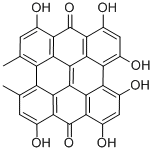| Hypericum perforatum extracts | Hypericin is an extract of Hypericum perforatum L.In 1957. It is first isolated from the Garcinia species Hypericum perforatum by human beings. Hypericin belongs to the bianthrone compounds, and it is the most biologically active substances. Hypericin is a yellowish brown to brown mobile powder, with slightly bitter taste. It is soluble in water, and can emit a special fragrance. It can inhibit the central nervous and has a sedative effect. Adding it to health care products can enhance immunity. It is also used as antidepressant drugs in Europe (especially in Germany). Hypericin also has a strong anti-viral effect, which can directly act on swine fever, foot and mouth disease and other viruses. In addition, it also has a good effect on killing highly pathogenic avian influenza virus.
Hypericum perforatum is one of the world’s best-selling herbs in recent years, mainly containing hyperoside, quercetin, chlorogenic acid, caffeic acid, imanin, hypericin and other ingredients.
Hypericin is a few thousandths of the whole Hypericum perforatum. There are certain requirements for its extraction and testing. Methanol extraction method is common used in the past. Due to the toxicity of methanol, now the method is converted to use ethanol to obtain the active ingredient. |
| Indications | Hypericin is an anti-virus and pure Chinese medicine preparations. It is the first choice for the prevention and treatment of avian influenza drugs.
1, avian influenza, atypical Newcastle disease, infectious bronchitis, avian infectious laryngotracheitis , bursa of Fabricius, duck plague, duck viral hepatitis, egg drop syndrome and other viral diseases.
2, poultry fever caused by high fever, dyspnea, cough, head and face swelling, crown hair purple, lack of energy, decreased feed intake, egg drop, producing more abnormal eggs.
3, for classical swine fever, blue ear disease, parvovirus, viral enteritis, infectious gastroenteritis and immune dysfunction.
4, Hypericin has a strong anti-viral effect both in vivo and in vitro. It has a strong inhibitory effect on the early replication of HIV. Hypericin can lead to cancer cell programmed death, with anti-cancer effect. It has a enhanced immune function for activating mononuclear phagocytic cells. In addition, it has a strong role in killing the highly pathogenic H5N1 and H9N2 subtype of avian influenza virus. |
| Uses | (1) Antidepressant, increase immunity.
(2) For the treatment of antidepressants, increase immunity. |
| Description | An anthroquinone derivative that is naturally found in the flower of H. perforatum (St. John’s wort) and has antidepressant, antiviral, and anticancer activities. Hypericin inhibits neuronal uptake of serotonin, norepinephrine, dopamine, GABA and L-glutamate, contributing to its antidepressant effects. It exerts broad spectrum phototoxic affects (IC50 = 140 – 1,570 nM) through induction of apoptotic signaling and formation of reactive oxygen species (ROS) in cancer cells. Hypericin also has in vitro activity, which can be enhanced with photo-activation, against a variety of viruses including HIV, influenza virus, hepatitis C, murine cytolomegalovirus, and herpes viruses. |
| Chemical Properties | Powder |
| Uses | It was used as reference standard in determining hypericins in St. John′s Wort using HPLC method. |
| Definition | ChEBI: Hypericin is a carbopolycyclic compound. It has a role as an antidepressant. It derives from a hydride of a bisanthene. |
| General Description | Produced by HWI Analytik
Exact content can be found on the certificate |
| Biological Activity | Photosensitive antiviral, anticancer and antidepressant agent derived from Hypericum perforatum (St John’s wort). Inactivates enveloped viruses (including HIV), inhibits tyrosine kinases (IC 50 = 7.5 μ M) and is preferentially cytotoxic to tumor cells upon stimulation by visible light. |
| Biochem/physiol Actions | Primary TargetPKC |
| Purification Methods | Crystallise hypericin from pyridine by addition of methanolic HCl. [Beilstein 8 IV 3761.] |
| References | 1) Kubin et al., (2005) Hypericin – the facts about a controversial agent; Current Pharm. Des., 11 233 2) Theodossiou et al., (2009) The multifaceted photocytotoxic profile of hypericin; Mol. Pharmacol., 6 1775 |
